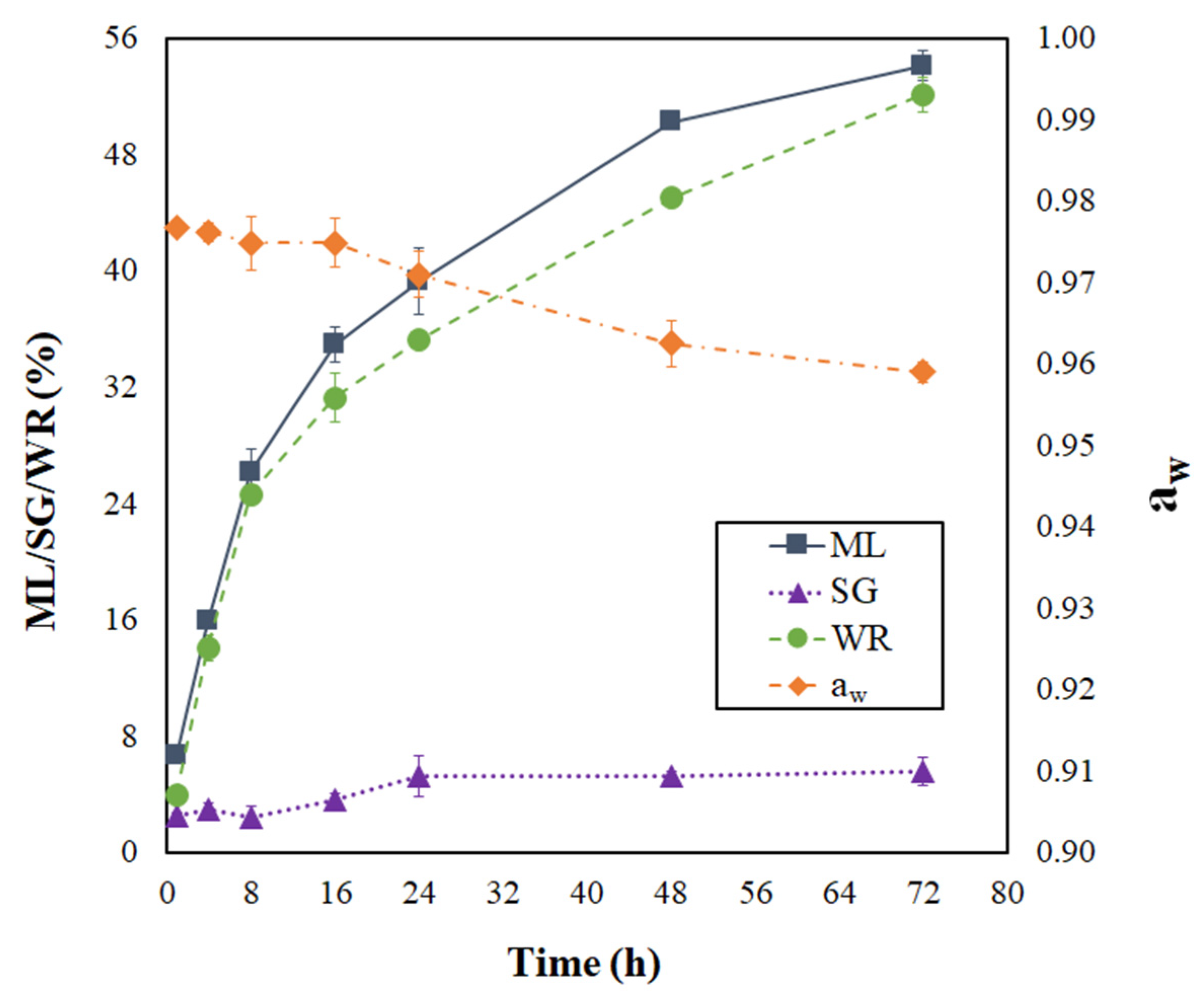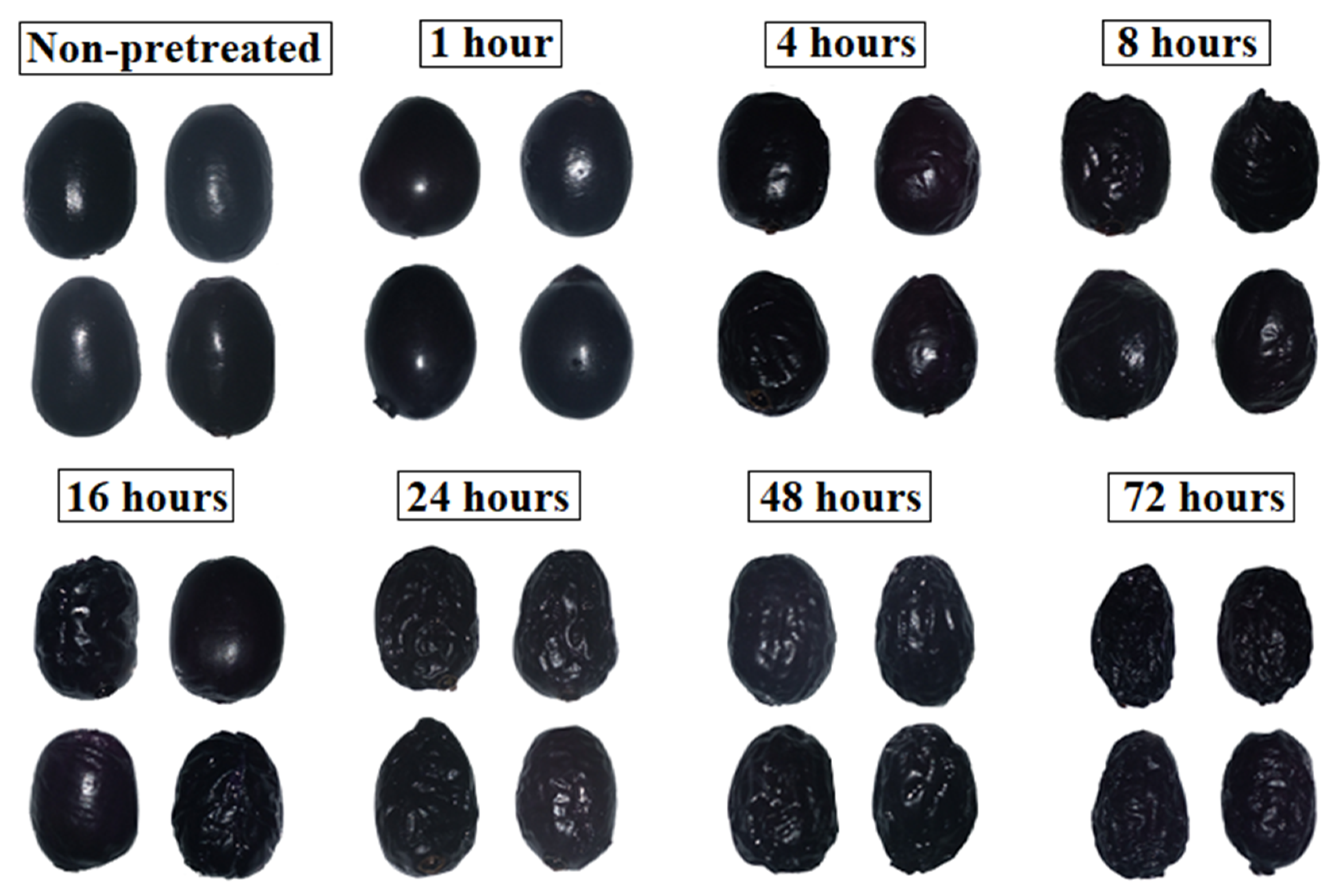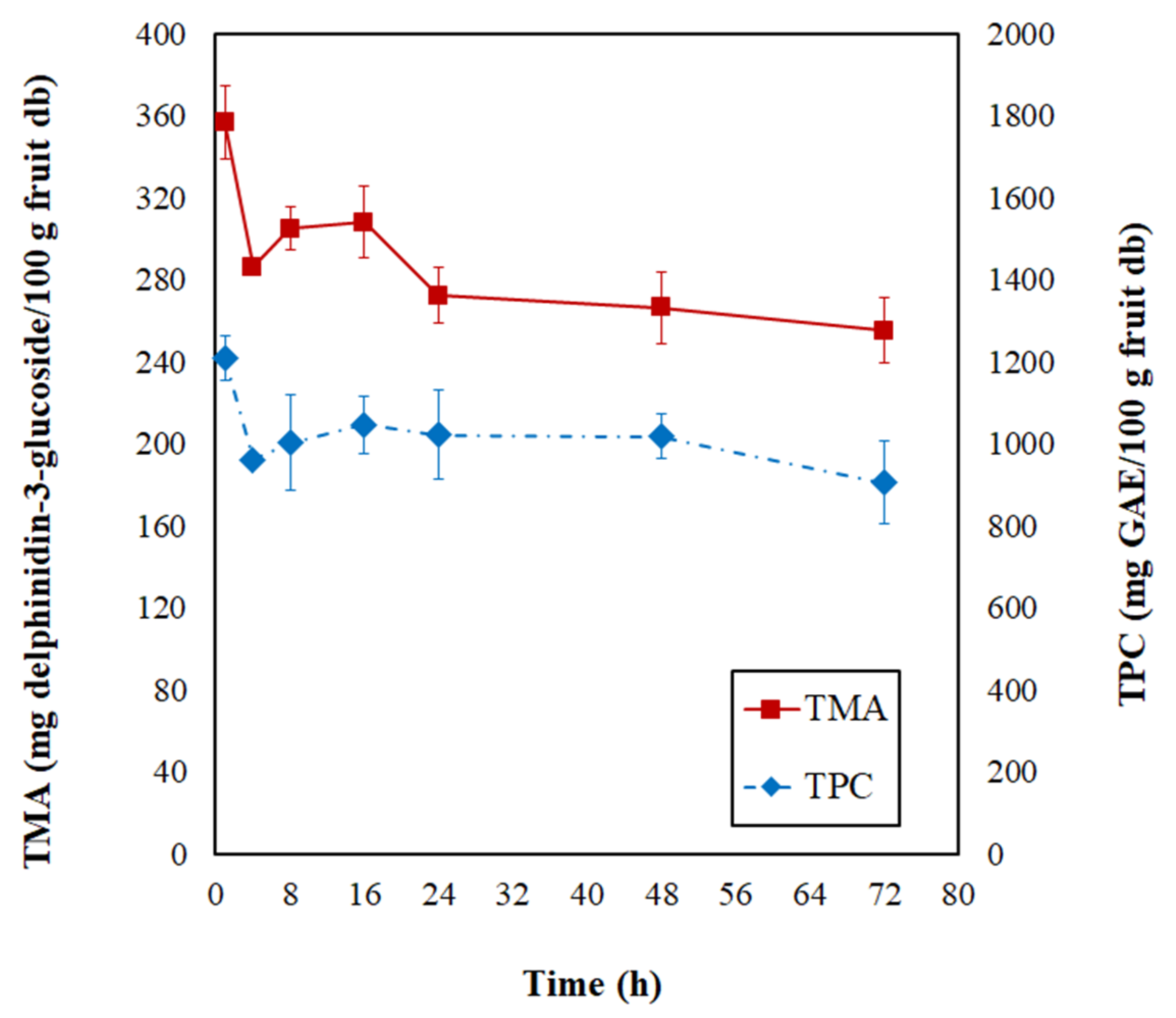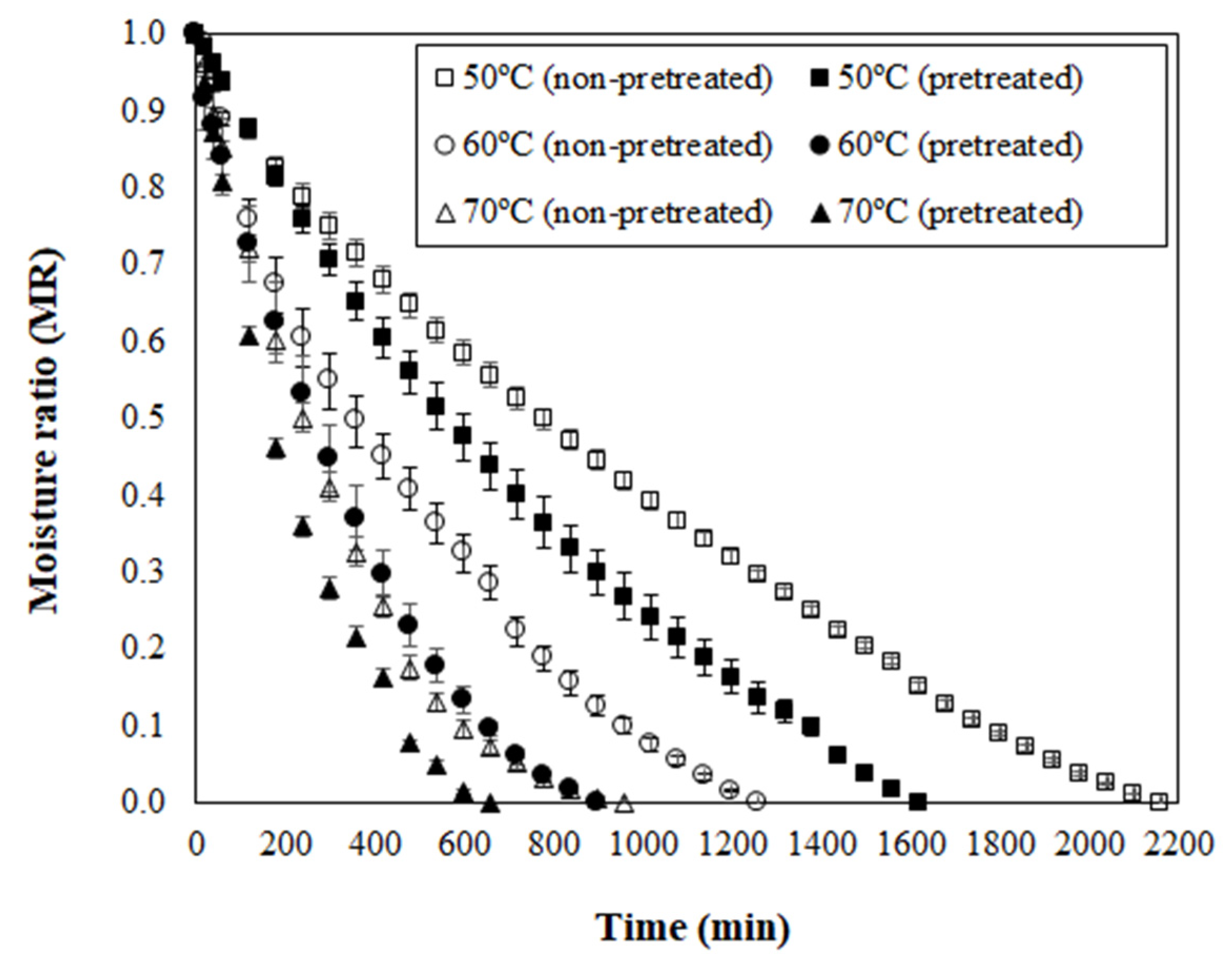Combined Pulsed Vacuum Osmotic Dehydration and Convective Air-Drying Process of Jambolan Fruits
Abstract
:1. Introduction
2. Materials and Methods
2.1. Plant Material
2.2. Osmotic Pretreatment
2.3. Convective Air-Drying Kinetics
2.4. Monitoring Analyses
2.4.1. Moisture Loss, Solid Gain, and Weight Reduction
2.4.2. Water Activity and Moisture Content
2.4.3. Total Monomeric Anthocyanins and Total Phenolic Contents
2.5. Pulsed Vacuum Osmotic Dehydration Modeling
2.5.1. Azuara’s Model
2.5.2. Peleg’s Model
2.6. Calculation of Effective Moisture Diffusivity
2.7. Drying Kinetics Modeling
3. Results and Discussion
3.1. Pulsed Vacuum Osmotic Dehydration Kinetic
3.1.1. Changes in Moisture Loss, Solid Gain, Weight Reduction, and Water Activity
3.1.2. Total Monomeric Anthocyanins and Total Phenolic Contents
3.1.3. Pulsed Vacuum Osmotic Dehydration Modeling
3.2. Drying Kinetics
3.2.1. Drying Kinetics of Pulsed Vacuum Osmotically Dehydrated Jambolan
3.2.2. Effective Moisture Diffusivities and Activation Energy for Drying Process
3.2.3. Drying Kinetics Modeling
3.2.4. Jambolan Aspects after Drying
3.3. Monitoring Analyses of Jambolan after Drying
3.3.1. Effect of Osmotic Pretreatment and Drying on Moisture Contents and Water Activities
3.3.2. Effect of Osmotic Pretreatment and Drying on Total Monomeric Anthocyanins and Total Phenolic Contents
4. Conclusions
Author Contributions
Funding
Institutional Review Board Statement
Informed Consent Statement
Data Availability Statement
Acknowledgments
Conflicts of Interest
References
- Singh, J.P.; Kaur, A.; Singh, N.; Nim, L.; Shevkani, K.; Kaur, H.; Arora, D.S. In vitro antioxidant and antimicrobial properties of jambolan (Syzygium cumini) fruit polyphenols. LWT-Food Sci. Technol. 2016, 65, 1025–1030. [Google Scholar] [CrossRef]
- Patras, A.; Brunton, N.; O’Donnel, C.; Tiwari, B.K. Effect of thermal processing on anthocyanin stability in foods; mechanisms and kinetics of degradation. Trends Food Sci. Technol. 2010, 21, 3–11. [Google Scholar] [CrossRef]
- Limsitthichaikoon, S.; Saodaeng, K.; Priprem, A.; Damrongrunggrang, T. Anthocyanin complex: Characterization and cytotoxicity studies. Int. J. Chem. Mol. Eng. 2015, 9, 147–153. [Google Scholar] [CrossRef]
- Lestario, L.N.; Howard, L.R.; Brownmiller, C.; Stebbins, N.B.; Liyanage, R.; Lay, J.O. Changes in polyphenolics during maturation of Java plum (Syzygium cumini Lam.). Food Res. Int. 2017, 100, 385–391. [Google Scholar] [CrossRef]
- Singh, B.; Singh, J.P.; Kaur, A.; Singh, N. Insights into the phenolic compounds present in jambolan (Syzygium cumini) along with their health-promoting effects. Int. J. Food Sci. Technol. 2018, 53, 2431–2447. [Google Scholar] [CrossRef]
- Silva, W.P.; Nunes, J.S.; Gomes, J.P.; Araújo, A.C.; Silva, C.M.D.P.S. Description of jambolan (Syzygium cumini (L.)) anthocyanin extraction kinetics at different stirring frequencies of the medium using diffusion models. Heat Mass Transf. 2018, 54, 3275–3285. [Google Scholar] [CrossRef]
- Sabino, L.B.S.; Brito, E.S.; Silva-Júnior, I.J. Jambolan—Syzygium Jambolanun. In Exotic Fruits; Rodrigues, S., Silva, E.O., Brito, E.S., Eds.; Academic Press: Chennai, India, 2018; pp. 251–256. [Google Scholar]
- Hssaini, L.; Ouaabou, R.; Charafi, J.; Idlimam, A.; Lamharrar, A.; Razouk, R.; Hanine, H. Hygroscopic proprieties of fig (Ficus carica L.): Mathematical modelling of moisture sorption isotherms and isosteric heat kinetics. S. Afr. J. Bot. 2022, 145, 265–274. [Google Scholar] [CrossRef]
- Karam, M.C.; Petit, J.; Zimmer, D.; Baudelaire Djantou, E.; Scher, J. Effects of drying and grinding in production of fruit and vegetable powders. J. Food Eng. 2016, 188, 32–49. [Google Scholar] [CrossRef]
- Pandiselvam, R.; Tak, Y.; Olum, E.; Sujayasree, O.J.; Tekgül, Y.; Koç, G.Ç.; Kaur, M.; Nayi, P.; Kothakota, A.; Kumar, M. Advanced osmotic dehydration techniques combined with emerging drying methods for sustainable food production: Impact on bioactive components, texture, color, and sensory properties of food. J. Texture Stud. 2022, 53, 737–762. [Google Scholar] [CrossRef] [PubMed]
- Manzoor, A.; Khan, M.A.; Mujeebu, M.A.; Shiekh, R.A. Comparative study of microwave assisted and conventional osmotic dehydration of apple cubes at constant temperature. J. Agri. Food Res. 2021, 5, 100176. [Google Scholar] [CrossRef]
- Yadav, A.K.; Singh, S.V. Osmotic dehydration of fruits and vegetables: A review. J. Food Sci. Technol. 2014, 51, 1654–1673. [Google Scholar] [CrossRef]
- Ramya, V.; Jain, N.K. A review on osmotic dehydration of fruits and vegetables: An integrated approach: Osmo-dehydration of fruits and vegetables. J. Food Process Eng. 2016, 40, e12440. [Google Scholar] [CrossRef]
- Ma, Y.; Yi, J.; Bi, J.; Zhao, Y.; Li, X.; Wu, X.; Du, Q. Effect of ultrasound on mass transfer kinetics and phenolic compounds of apple cubes during osmotic dehydration. LWT-Food Sci. Technol. 2021, 151, 112186. [Google Scholar] [CrossRef]
- Carmo, J.R.; Corrêa, J.L.G.; Resende, M.; Cirillo, M.A.; Corona-Jiménez, E.; Telis-Romero, J. Mango enriched with sucrose and isomaltulose (Palatinose®) by osmotic dehydration: Effect of temperature and solute concentration through the application of multilevel statistical models. J. Food Process. Preserv. 2022, 46, e17147. [Google Scholar] [CrossRef]
- Macedo, L.L.; Corrêa, J.L.G.; Petri Júnior, I.; Araújo, C.S.; Vimercati, W.C. Intermittent microwave drying and heated air drying of fresh and isomaltulose (Palatinose) impregnated strawberry. LWT-Food Sci. Technol. 2022, 155, 112918. [Google Scholar] [CrossRef]
- Macedo, L.L.; Corrêa, J.L.G.; Vimercati, W.C.; Araújo, C.S. The impact of using vacuum and isomaltulose as an osmotic agent on mass exchange during osmotic dehydration and their effects on qualitative parameters of strawberries. J. Food Process Eng. 2022, 45, e14057. [Google Scholar] [CrossRef]
- Silva, K.S.; Fernandes, M.A.; Mauro, M.A. Effect of calcium on the osmotic dehydration kinetics and quality of pineapple. J. Food Eng. 2017, 134, 37–44. [Google Scholar] [CrossRef]
- Tappi, S.; Mauro, M.A.; Tylewics, U.; Dellarosa, N.; Della Rosa, M.; Rocculi, P. Effects of calcium lactate and ascorbic acid on osmotic dehydration kinetics and metabolic profile of apples. Food Bioprod. Process. 2017, 103, 1–9. [Google Scholar] [CrossRef]
- Sahin, U.; Öztürk, H.K. Effects of pulsed vacuum osmotic dehydration (PVOD) on drying kinetics of figs (Ficus carica L). Innov. Food Sci. Emerg. Technol. 2016, 36, 104–111. [Google Scholar] [CrossRef]
- Junqueira, J.R.J.; Corrêa, J.; Mendonça, K.; Mello, R.E., Jr. Pulsed vacuum osmotic dehydration of beetroot, carrot and eggplant slices: Effect of vacuum pressure on the quality parameters. Food Bioproc. Technol. 2018, 11, 1863–1875. [Google Scholar] [CrossRef]
- Mello, R., Jr.; Corrêa, J.L.G.; Lopes, F.J.; Souza, A.U.; Silva, K.C.R. R. Kinetics of the pulsed vacuum osmotic dehydration of green fig (Ficus carica L.). Heat Mass Transf. 2019, 55, 1685–1691. [Google Scholar] [CrossRef]
- Junqueira, J.R.J.; Corrêa, J.L.G.; Mendonça, K.S.; Mello Júnior, R.E.; Souza, A.U. Modeling mass transfer during osmotic dehydration of different vegetable structures under vacuum conditions. Food Sci. Technol. 2021, 41, 439–448. [Google Scholar] [CrossRef]
- Ghellam, M.; Zannou, O.; Galanakis, C.M.; Aldawoud, T.M.S.; Ibrahim, S.A.; Koca, I. Vacuum-assisted osmotic dehydration of autumn olive berries: Modeling of mass transfer kinetics and quality assessment. Foods 2021, 10, 2286. [Google Scholar] [CrossRef] [PubMed]
- Sharma, M.; Dash, K.K. Effect of ultrasonic vacuum pretreatment on mass transfer kinetics during osmotic dehydration of black jamun fruit. Ultrason. Sonochem. 2019, 58, 104693. [Google Scholar] [CrossRef]
- Araújo, A.L.; Pena, R.S. Influence of process conditions on the mass transfer of osmotically dehydrated jambolan fruits. Food Sci. Technol. 2022, 42, e37520. [Google Scholar] [CrossRef]
- Kucner, A.; Klewicki, R.; Sójka, M. The influence of selected osmotic dehydration and pretreatment parameters on dry matter and polyphenol content in highbush blueberry (vaccinium corymbosum l.) fruits. Food Bioproc. Technol. 2013, 6, 2031–2047. [Google Scholar] [CrossRef]
- Sridevi, M.; Genitha, E.T.R. Optimization of osmotic dehydration process of pineapple by response surface methodology. J. Food Process. Technol. 2012, 3, 441–448. [Google Scholar]
- AOAC. Official Methods of Analysis of AOAC International, 17th ed.; AOAC International: Gaithersburg, MD, USA, 2002. [Google Scholar]
- Brito, B.N.C.; Pena, R.S.; Lopes, A.S.; Chisté, R.C. Anthocyanins of jambolão (Syzygium cumini): Extraction and pH-dependent color changes. J. Food Sci. 2017, 82, 2286–2290. [Google Scholar] [CrossRef] [PubMed]
- Singleton, V.L.; Rossi, J.A. Colorimetry of total phenolic with phosphomolybdic-phosphotungstic acid reagents. Am. J. Enol. Vitic. 1965, 16, 144–158. [Google Scholar] [CrossRef]
- Giusti, M.M.; Wrolstad, R.E. Characterization and measurement with UV-visible spectroscopy. Curr. Protoc. Food Anal. Chem. 2001, 3, F1.2.1–F1.2.13. [Google Scholar] [CrossRef]
- Azuara, E.; Cortés, R.; Garcia, H.S.; Beristain, C.I. Kinetic model for osmotic dehydration and its relationship with Fick’s second law. Int. J. Food Sci. Technol. 1992, 27, 409–418. [Google Scholar] [CrossRef]
- Peleg, M. An empirical model for the description of moisture curves. J. Food Sci. 1988, 53, 1216–1217. [Google Scholar] [CrossRef]
- Crank, J. The Mathematics of Diffusion, 2nd ed.; Clarendon Press: Bristol, UK, 1975; pp. 340–341. [Google Scholar]
- Xanthopoulos, G.; Yanniotis, S.; Lambrinos, G. Water diffusivity and drying kinetics of air drying of figs. Dry. Technol. 2009, 27, 502–512. [Google Scholar] [CrossRef]
- Sacilik, K.; Elicin, A.K.; Unal, G. Drying kinetics of Üryani plum in a convective hot air-drying. J. Food Eng. 2006, 76, 362–368. [Google Scholar] [CrossRef]
- Akpinar, E.K.; Bicer, Y.; Yildiz, C. Thin layer drying of red pepper. J. Food Eng. 2003, 59, 99–104. [Google Scholar] [CrossRef]
- Rastogi, N.K.; Raghavarao, K.S.M.S. Water and solute diffusion coefficients of carrot as a function of temperature and concentration. J. Food Eng. 1997, 34, 429–440. [Google Scholar] [CrossRef]
- Rastogi, N.K.; Raghavarao, K.S.M.S.; Niranjan, K.; Knorr, D. Recent development in osmotic dehydration: Methods to enhance mass transfer. Trends Food Sci. Technol. 2002, 13, 48–59. [Google Scholar] [CrossRef]
- Erkmen, O.; Bozoglu, T.F. Food preservation by reducing water activity. In Food Microbiology: Principles into Practice; Erkmen, O., Bozolgu, T.F., Eds.; John Wiley & Sons: Hoboken, NJ, USA, 2016; Volume 2, pp. 44–58. [Google Scholar]
- Araújo, A.L.; Pena, R.S. Moisture desorption behavior and thermodynamic properties of pulp and seed of jambolan (Syzygium cumini). Heliyon 2022, 8, e09443. [Google Scholar] [CrossRef]
- Junqueira, J.R.J.; Corréa, J.G.; Mendonça, K.S. Evaluation of the shrinkage effect on the modeling kinetics of osmotic dehydration of sweet potato (Ipomoea batatas (L.)). J. Food Process. Preserv. 2016, 41, e12881. [Google Scholar] [CrossRef]
- Zielinska, M.; Zielinska, D.; Markowski, M. The effect of microwave-vacuum pretreatment on the drying kinetics, color and the content of bioactive compounds in osmo-microwave-vacuum dried cranberries (Vaccinium macrocarpon). Food Bioproc. Technol. 2018, 11, 585–602. [Google Scholar] [CrossRef]
- Yu, Y.; Jin, T.Z.; Fan, X.; Wu, J. Biochemical degradation and physical migration of polyphenolic compounds in osmotic dehydrated blueberries with pulsed electric field and thermal pretreatment. Food Chem. 2018, 239, 1219–1225. [Google Scholar] [CrossRef]
- Evert, R.F.; Eichhorn, S.E. Raven Biology of Plants, 8th ed.; W. H. Freeman and Company: New York, NY, USA, 2013; p. 900. [Google Scholar]
- Nowicka, P.; Wojdyło, A.; Lech, K.; Figiel, A. Influence of osmodehydration pretreatment and combined drying method on the bioactive potential of sour cherry fruits. Food Bioproc. Technol. 2015, 8, 824–836. [Google Scholar] [CrossRef]
- Araya-Farias, M.; Macaigme, O.; Ratti, C. On the development of osmotically dehydrated seabuckthorn fruits: Pretreatments, osmotic dehydration, post drying techniques, and nutritional quality. Dry. Technol. 2014, 32, 813–819. [Google Scholar] [CrossRef]
- Sójka, A.; Karlinska, E.; Klewicki, R. Ellagitannin and anthocyanin retention in osmotically dehydrated blackberries. Food Sci. Technol. Res. 2017, 23, 801–810. [Google Scholar] [CrossRef]
- Blanda, G.; Cerretani, L.; Cardinali, A.; Barbieri, S.; Bendini, A.; Lercker, G. Osmotic dehydrofreezing of strawberries: Polyphenolic content, volatile profile and consumer acceptance. LWT-Food Sci. Technol. 2009, 42, 30–36. [Google Scholar] [CrossRef]
- Souraki, B.A.; Ghavami, M.; Tondro, H. Simulation of osmotic dehydration of a spherical material using parabolic and powerlaw approximation methods. Chem. Eng. Commun. 2014, 202, 1607–1617. [Google Scholar] [CrossRef]
- Krokida, M.K.; Maroulis, Z.B. Structural properties of dehydrated products during rehydration. Int. J. Food Sci. Technol. 2001, 36, 529–538. [Google Scholar] [CrossRef]
- Garba, U.; Kaur, S.; Gurumayum, S.; Rasane, P. Effect of hot water blanching time and drying temperature on the thin layer drying kinetics of and anthocyanin degradation in black carrot (Daucus carota L.) shreds. Food Technol. Biotechnol. 2015, 53, 324–330. [Google Scholar] [CrossRef]
- Potosí-Calvache, D.C.; Vanegas-Mahecha, P.; Martínez-Correa, H.A. Convective drying of squash (Cucurbita moschata): Influence of temperature and air velocity on effective moisture diffusivity, carotenoid content and total phenols. DYNA 2017, 84, 112–119. [Google Scholar] [CrossRef]
- An, K.; Li, H.; Zhao, D.; Ding, S.; Tao, H.; Wang, Z. Effect of osmotic dehydration with pulsed vacuum on hot-air drying kinetics and quality attributes of cherry tomatoes. Dry. Technol. 2013, 31, 698–706. [Google Scholar] [CrossRef]
- Fito, P.; Chiralt, A.; Barat, J.M.; Andrés, A.; Martínez-Monzo, J.; Martinéz-Navarrete, N. Vacuum impregnation for development of new dehydrated products. J. Food Eng. 2001, 49, 297–302. [Google Scholar] [CrossRef]
- Madamba, P.S.; Griscoll, R.H.; Buckle, K.A. The thin layer drying characteristics of garlic slices. J. Food Eng. 1996, 29, 75–97. [Google Scholar] [CrossRef]
- Barathiraja, R.; Thirumal, P.; Thirumalaikumarasamy, D.; Kajavali, A.; Ashokkumar, M.; ThiyagaRaj, J. Investigation of drying kinetics and qualities of turkey berry in fluidized bed dryer. Mater. Today Proc. 2021, 46, 7711–7718. [Google Scholar] [CrossRef]
- Martín-Gómez, J.; Ángeles Varo, M.; Mérida, J.; Serratosa, M.P. Influence of drying processes on anthocyanin profiles, total phenolic compounds and antioxidant activities of blueberry (Vaccinium corymbosum). LWT-Food Sci. Technol. 2020, 120, 108931. [Google Scholar] [CrossRef]
- Falade, K.O.; Oyedele, O.O. Effect of osmotic pretreatment on air drying characteristics and colour of pepper (Capsicum spp) cultivars. J. Food Sci. Technol. 2010, 47, 488–495. [Google Scholar] [CrossRef] [PubMed]
- Xiao, H.W.; Pang, C.L.; Wang, L.H.; Bai, J.W.; Yang, W.X.; Gao, Z.J. Drying kinetics and quality of Monukka seedless grapes dried in an air-impingement jet dryer. Biosyst. Eng. 2010, 105, 233–240. [Google Scholar] [CrossRef]
- Amami, E.; Khezami, W.; MezriguI, S.; Badwaik, L.B.; Bejar, A.K.; Perez, C.T.; Kechaou, N. Effect of ultrasound-assisted osmotic dehydration pretreatment on the convective drying of strawberry. Ultrason. Sonochem. 2017, 36, 286–300. [Google Scholar] [CrossRef] [PubMed]
- Purlis, E. Modelling convective drying of foods: A multiphase porous media model considering heat of sorption. J. Food Eng. 2019, 263, 132–146. [Google Scholar] [CrossRef]
- Babalis, S.J.; Belessiotis, V.G. Influence of the drying conditions on the drying constants and moisture diffusivity during the thin-layer drying of figs. J. Food Eng. 2004, 65, 449–458. [Google Scholar] [CrossRef]
- Wiktor, A.; Iwaniuk, M.; Śledź, M.; Nowacka, M.; Chudoba, T.; Witrowa-Rajchert, D. Drying kinetics of apple tissue treated by pulsed electric field. Dry. Technol. 2013, 31, 112–119. [Google Scholar] [CrossRef]
- Wisniak, J.; Polishuk, A. Analysis of residuals—A useful tool for phase equilibrium data analysis. Fluid Ph. Equilibria 1999, 164, 61–82. [Google Scholar] [CrossRef]
- Assis, F.R.; Morais, R.M.S.C.; Morais, A.M.M.B. Mathematical modelling of osmotic dehydration kinetics of apple cubes. J. Food Process. Preserv. 2017, 41, e12895. [Google Scholar] [CrossRef]
- Puente-Díaz, L.; Ah-Hen, K.; Veja-Gálvez, A.; Lemus-Mondaca, R.; Scala, K.D. Combined infrared-convective drying of murta (Ugni molinae Turcz) berries: Kinetic modeling and quality assessment. Dry. Technol. 2013, 31, 329–338. [Google Scholar] [CrossRef]
- Bialik, M.; Wiktor, A.; Witrowa-Rajchert, D.; Gondek, E. The influence of osmotic dehydration conditions on drying kinetics and total carotenoid content of kiwiberry (actinidia arguta). Int. J. Food Eng. 2020, 16, 20180328. [Google Scholar] [CrossRef]
- Liu, Z.L.; Xie, L.; Zielinska, M.; Pan, Z.; Deng, L.; Zhang, J.; Gao, L.; Wang, S.; Zheng, Z.; Xiao, H. Improvement of drying efficiency and quality attributes of blueberries using innovative far-infrared radiation heating assisted pulsed vacuum drying (FIR-PVD). Innov. Food Sci. Emerg. Technol. 2022, 77, 102948. [Google Scholar] [CrossRef]
- Chandra, A.; Kumar, S.; Tarafdar, A.; Nema, P.K. Ultrasonic and osmotic pretreatments followed by convective and vacuum drying of papaya slices. J. Sci. Food Agric. 2020, 101, 2264–2272. [Google Scholar] [CrossRef] [PubMed]
- Kowalska, H.; Marzec, A.; Kowalska, J.; Trych, U.; Masiarz, E.; Lenart, A. The use of a hybrid drying method with pre-osmotic treatment in strawberry bio-snack technology. Int. J. Food Eng. 2020, 16, 20180318. [Google Scholar] [CrossRef]
- Reid, D.S.; Fennema, O. Water and ice. In Fennema’s Food Chemestry, 3rd ed.; Damodaran, S., Parkin, J.L., Fennema, O., Eds.; CRC Press: New York, NY, USA, 2008; pp. 17–94. [Google Scholar]
- Scott, W.J. Water relations of food spoilage microorganisms. Adv. Food Res. 1957, 7, 83–127. [Google Scholar] [CrossRef]
- Méndez-Lagunas, L.; Rodríguez-Ramírez, J.; Cruz-Gracida, M.; Sandoval-Torres, S.; Barriada-Bernal, G. Convective drying kinetics of strawberry (Fragaria ananassa): Effects on antioxidant activity, anthocyanins and total phenolic content. Food Chem. 2017, 230, 174–181. [Google Scholar] [CrossRef] [PubMed]
- Schwartz, S.J.; Cooperstone, J.L.; Cichon, M.J.; Von Elbe, J.H.; Giusti, M. Colorants. In Fennema’s Food Chemistry, 5th ed.; Damodaran, S., Parkin, K.L., Eds.; CRC Press: Boca Raton, FL, USA, 2017; Volume 1, pp. 677–748. [Google Scholar]
- Maillard, M.N.; Berset, C. Evolution of antioxidant activity during kilning: Role of insoluble bound phenolic acids of barley and malt. J. Agric. Food Chem. 1995, 43, 1789–1793. [Google Scholar] [CrossRef]
- Tan, S.; Miao, Y.; Zhou, C.; Luo, Y.; Lin, Z.; Xie, R.; Li, W. Effects of hot air drying on drying kinetics and anthocyanin degradation of blood-flesh peach. Foods 2022, 11, 1596. [Google Scholar] [CrossRef] [PubMed]
- Nunes, M.C.N.; Brecht, J.K.; Morais, A.M.B.; Sargent, S.A. Possible influences of water loss and polyphenol oxidase activity on anthocyanin content and discoloration in fresh ripe strawberry (CV. Oso grande) during storage at 1 °C. J. Food Sci. 2005, 70, 579–584. [Google Scholar] [CrossRef]
- Maghsoudlou, Y.; Guajari, M.A.; Tavasoli, S. Effects of heat treatment on the phenolic compounds and antioxidant activity of quince fruit and its tisane’s sensory properties. J. Food Sci. Technol. 2019, 56, 2365–2372. [Google Scholar] [CrossRef] [PubMed]




| Model | Mathematical Equation | Equation |
|---|---|---|
| Newton | (14) | |
| Page | (15) | |
| Modified Page | (16) | |
| Henderson and Pabis | − | (17) |
| Logarithm | (18) | |
| Midilli | (19) | |
| Two-term | (20) | |
| Diffusion approximation | (21) | |
| Two-term exponential | (22) |
| Moisture Loss | Solid Gain | ||||||||
|---|---|---|---|---|---|---|---|---|---|
| Azuara’s Model | |||||||||
| k | MLꝏ | R2 | RMSE | k | SGꝏ | R2 | RMSE | ||
| 0.09 | 61.73 | 1 | 0.66 | 0.17 | 5.95 | 0.98 | 0.23 | ||
| Peleg’s Model | |||||||||
| k1 | k2 | MLꝏ | R2 | RMSE | k1 | k2 | SGꝏ | R2 | RMSE |
| 0.19 | 0.02 | 61.99 | 0.99 | 0.53 | 0.73 | 0.18 | 5.46 | 0.58 | 0.22 |
| Temperature (°C) | Deff (m2/s) | Ea (kJ/mol) |
|---|---|---|
| Non-pretreated | ||
| 50 | 1.45 × 10−10 | 52.0 |
| 60 | 3.85 × 10−10 | |
| 70 | 4.46 × 10−10 | |
| Pretreated | ||
| 50 | 2.56 × 10−10 | 30.2 |
| 60 | 3.99 × 10−10 | |
| 70 | 4.93 × 10−10 | |
| Model | Statistics | |||||||||||
|---|---|---|---|---|---|---|---|---|---|---|---|---|
| 50 °C | 60 °C | 70 °C | ||||||||||
| R2 | χ2 (×10−4) | RMSE (×10−2) | RD | R2 | χ2 (×10−5) | RMSE (×10−2) | RD | R2 | χ2 (×10−5) | RMSE (×10−2) | RD | |
| Non-pretreated | ||||||||||||
| 1 | 0.97 | 25 | 5 | B | 0.99 | 13 | 3 | B | 0.99 | 15 | 4 | B |
| 2 | 0.99 | 14 | 4 | B | 0.99 | 10 | 3 | B | 1 | 3 | 4 | R |
| 3 | 0.99 | 14 | 4 | B | 0.99 | 9 | 3 | B | 1 | 3 | 2 | R |
| 4 | 0.98 | 24 | 5 | B | 0.99 | 13 | 3 | B | 0.99 | 12 | 3 | B |
| 5 | 1 | 1 | 1 | B | 1 | 4 | 2 | R | 1 | 3 | 1 | B |
| 6 | 1 | 0.4 | 1 | R | 1 | 2 | 1 | R | 1 | 1 | 1 | R |
| 7 | 0.98 | 25 | 5 | B | 0.99 | 14 | 3 | B | 0.99 | 14 | 3 | B |
| 8 | 1 | 3 | 2 | B | 1 | 3 | 2 | R | 1 | 2 | 1 | B |
| 9 | 0.99 | 14 | 4 | B | 0.99 | 10 | 3 | B | 1 | 3 | 2 | R |
| Pretreated | ||||||||||||
| 1 | 0.98 | 21 | 5 | B | 0.99 | 16 | 4 | B | 0.99 | 11 | 3 | R |
| 2 | 0.99 | 7 | 3 | B | 0.99 | 9 | 3 | B | 1 | 5 | 2 | R |
| 3 | 0.99 | 7 | 3 | B | 0.99 | 9 | 3 | B | 1 | 5 | 2 | R |
| 4 | 0.98 | 18 | 4 | B | 0.99 | 16 | 4 | B | 0.99 | 9 | 3 | R |
| 5 | 1 | 0.3 | 1 | R | 1 | 1 | 1 | R | 1 | 2 | 1 | R |
| 6 | 1 | 0.2 | 0.4 | R | 1 | 1 | 1 | R | 1 | 2 | 1 | R |
| 7 | 0.99 | 7 | 2 | B | 0.99 | 18 | 4 | B | 1 | 2 | 1 | R |
| 8 | 1 | 0.2 | 0.4 | R | 1 | 2 | 1 | B | 1 | 5 | 2 | R |
| 9 | 0.99 | 8 | 3 | B | 0.99 | 8 | 3 | B | 1 | 5 | 2 | R |
| Jambolan Treatments | MC | aw | TMA | TPC |
|---|---|---|---|---|
| NPT | 87.32 ± 0.13 a | 0.980 ± <0.001 a | 477.89 ± 16.83 a | 1236.13 ± 57.56 a |
| NPT and dried at 50 °C | 29.78 ± 0.26 c | 0.712 ± 0.001 d | 81.24 ± 5.33 c | 1230.30 ± 34.42 ab |
| NPT and dried at 60 °C | 28.34 ± 0.77 c | 0.758 ± 0.001 c | 80.02 ± 0.10 c | 952.86 ± 43.38 c |
| NPT and dried at 70 °C | 20.88 ± 0.26 e | 0.582 ± 0.001 g | 68.31 ± 7.97 cd | 1041.30 ± 5.67 bc |
| PT | 69.38 ± 0.56 b | 0.959 ± 0.001 b | 255.35 ± 15.90 b | 906.80 ± 101.09 c |
| PT and dried at 50 °C | 24.21 ± 0.46 d | 0.672 ±< 0.001 e | 23.21 ± 2.38 d | 557.88 ± 36.92 d |
| PT and dried at 60 °C | 17.34 ± 0.33 f | 0.599 ± 0.001 f | 46.06 ± 1.41 cd | 1056.22 ± 15.19 abc |
| PT and dried at 70 °C | 17.79 ± 0.76 f | 0.555 ± 0.001 h | 40.08 ± 1.57 cd | 854.55 ± 20.78 c |
Disclaimer/Publisher’s Note: The statements, opinions and data contained in all publications are solely those of the individual author(s) and contributor(s) and not of MDPI and/or the editor(s). MDPI and/or the editor(s) disclaim responsibility for any injury to people or property resulting from any ideas, methods, instructions or products referred to in the content. |
© 2023 by the authors. Licensee MDPI, Basel, Switzerland. This article is an open access article distributed under the terms and conditions of the Creative Commons Attribution (CC BY) license (https://creativecommons.org/licenses/by/4.0/).
Share and Cite
Araújo, A.L.d.; Pena, R.d.S. Combined Pulsed Vacuum Osmotic Dehydration and Convective Air-Drying Process of Jambolan Fruits. Foods 2023, 12, 1785. https://doi.org/10.3390/foods12091785
Araújo ALd, Pena RdS. Combined Pulsed Vacuum Osmotic Dehydration and Convective Air-Drying Process of Jambolan Fruits. Foods. 2023; 12(9):1785. https://doi.org/10.3390/foods12091785
Chicago/Turabian StyleAraújo, Adriano Lucena de, and Rosinelson da Silva Pena. 2023. "Combined Pulsed Vacuum Osmotic Dehydration and Convective Air-Drying Process of Jambolan Fruits" Foods 12, no. 9: 1785. https://doi.org/10.3390/foods12091785
APA StyleAraújo, A. L. d., & Pena, R. d. S. (2023). Combined Pulsed Vacuum Osmotic Dehydration and Convective Air-Drying Process of Jambolan Fruits. Foods, 12(9), 1785. https://doi.org/10.3390/foods12091785





